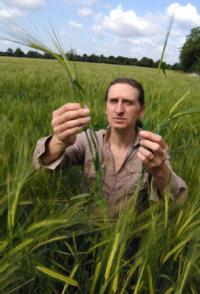Warwick, United Kingdom
February 6, 2014
 Scientists have for the first time sequenced an ancient RNA genome – of a barley virus once believed to be only 150 years old - pushing its origin back at least 2,000 years and revealing how intense farming at the time of the Crusades contributed to its spread.
Scientists have for the first time sequenced an ancient RNA genome – of a barley virus once believed to be only 150 years old - pushing its origin back at least 2,000 years and revealing how intense farming at the time of the Crusades contributed to its spread.
Researchers at the University of Warwick have detected and sequenced the RNA genome of Barley Stripe Mosaic Virus (BSMV) in a 750-year-old barley grain found at a site near the River Nile in modern-day Egypt. Their study is published in the journal Scientific Reports.
This new find challenges current beliefs about the age of the BSMV virus, which was first discovered in 1950 with the earliest record of symptoms just 100 years ago.
Although ancient DNA genomes have been sequenced before, ancient RNA genomes have not been as RNA breaks down more rapidly than DNA – generally around 50 times as fast.
However in extremely dry conditions, such as those at the site in Qasr Ibrim in Lower Nubia where the barley was found, RNA can be better preserved and this has allowed the scientists to successfully sequence its genome.
Using the new medieval RNA to calibrate estimates of the rate of mutations, the researchers were able to trace the evolution of the Barley Stripe Mosaic Virus to a probable origin of around 2,000 years ago, but potentially much further back to the domestication of barley in the Near East around 11,000 years ago.
BSMV is transmitted through seed-to-seed contact so it is likely to originally have been transferred from the wild grass population to an early cultivated form of barley while the seeds were stored.
Dr Robin Allaby of the School of Life Sciences at the University of Warwick, who led the study, said: “It is important to know as much as we can about virus evolution as emerging infectious plant diseases are a growing threat to global food security, and of those viruses account for almost half.
“History tells us about the devastation caused by the emergence of disease from wild hosts in disparate countries, such as the Central American origin of the oomycete that led to the Irish potato famine.
“We need to build up an accurate picture of the evolution of different types of virus so we can make better decisions about policies on plant movement.
“The medieval RNA from Qasr Ibrim gives us a vital clue to unlock the real age of the Barley Stripe Mosaic Virus.
“It is very difficult to understand how a plant disease evolved by solely relying on recent samples, however this 750-year-old example of the virus allows us to more accurately estimate its evolution rates and date of origin.
“Without the Medieval RNA evidence, the virus appears to be much younger than it actually is, when in fact its origins go back thousands of years.
“It’s possible that other viruses that similarly appear to be very recent may in fact have a more ancient origin.”
The researchers believe that the Medieval BSMV genome came from a time of rapid expansion of the plant disease in the Near East and Europe.
This coincided with the tumult of the Crusades which saw the Christian lands of Europe take arms against the Muslim territories of the Near East with their sights set on the city of Jerusalem. The seventh Crusade of Louis IX in 1234 is the most closely aligned in date to the origin of the virus expansion.
The researchers believe the massive war effort could have caused the virus to spread, fuelled by an intensification of farming in order to feed the armies engaged in the campaign.
This made contact with cultivated barley and wild grass more likely, providing opportunities for the virus to ‘jump’ into the crop.
Genetic evidence also points to a split into an east and west BSMV lineage around the end of the 15th century, around 100 years after the Mongol Empire stabilised the Silk Road. It is likely that BSMV was transported to the east via trade routes such as the Silk Road in the late Medieval period.
In more recent history, the virus appears to have spread to the US from Europe around 120-150 years ago.
The research was supported by the research funding body BBSRC.